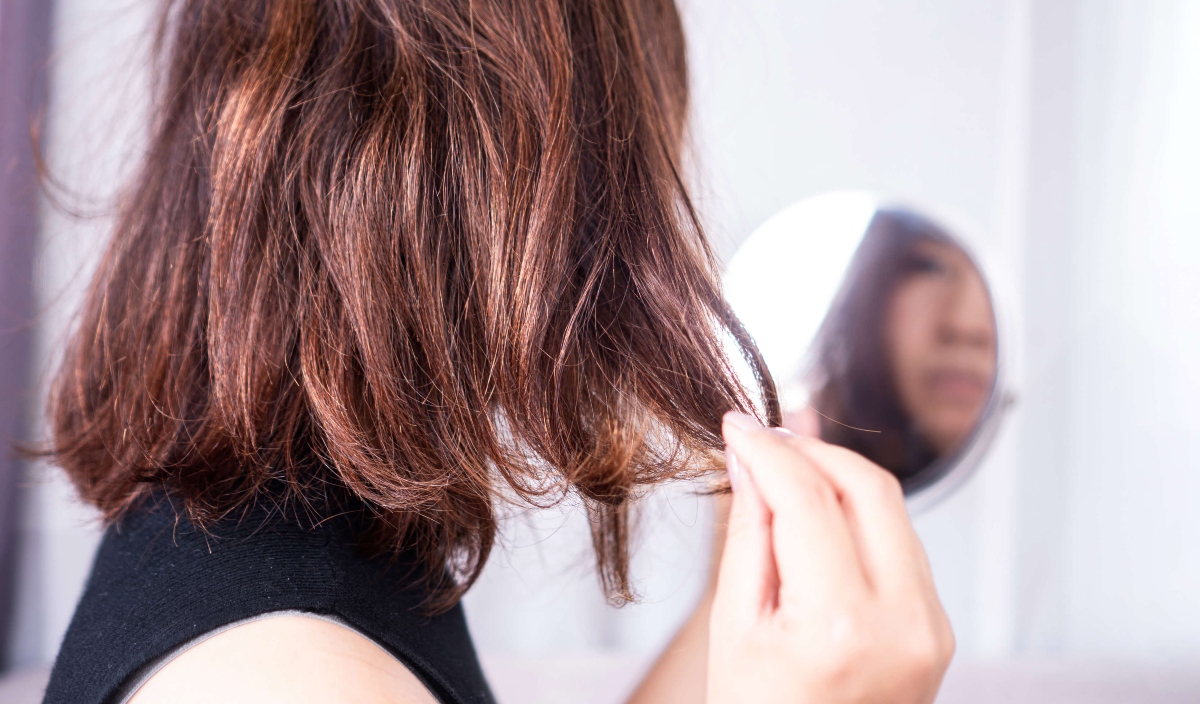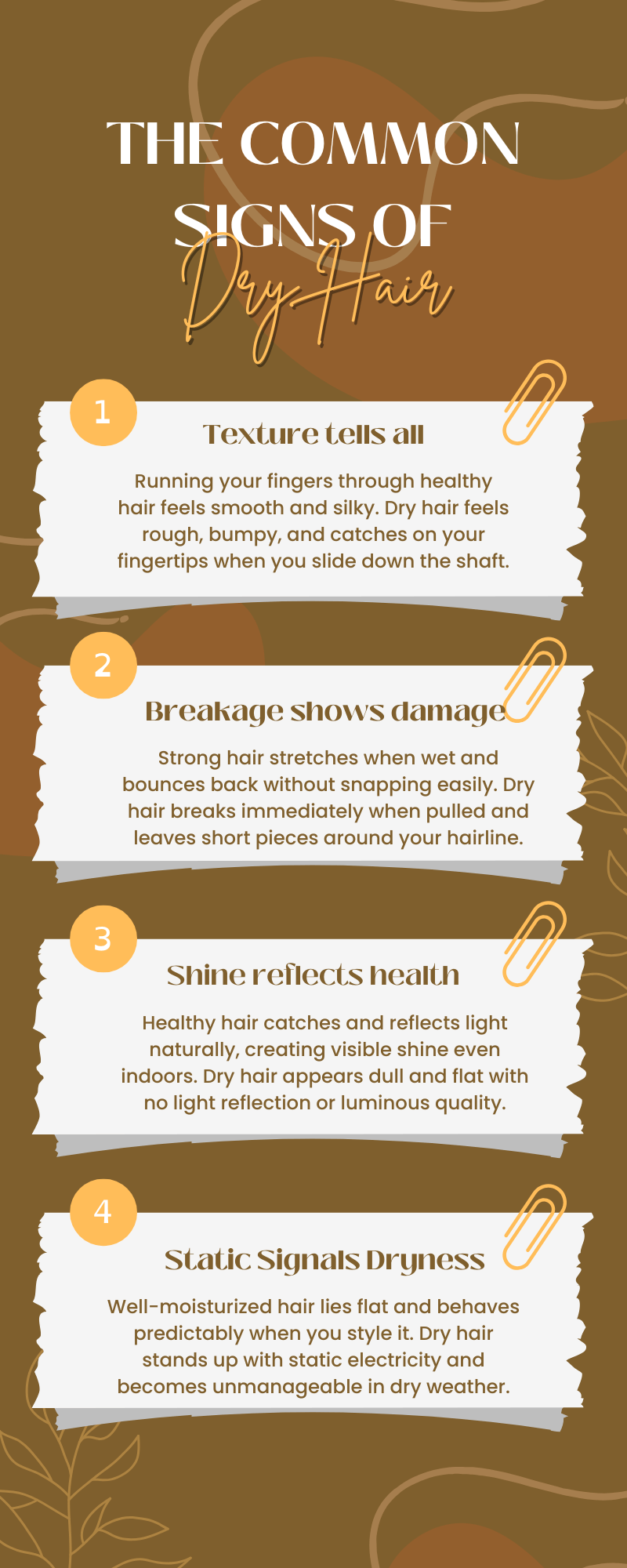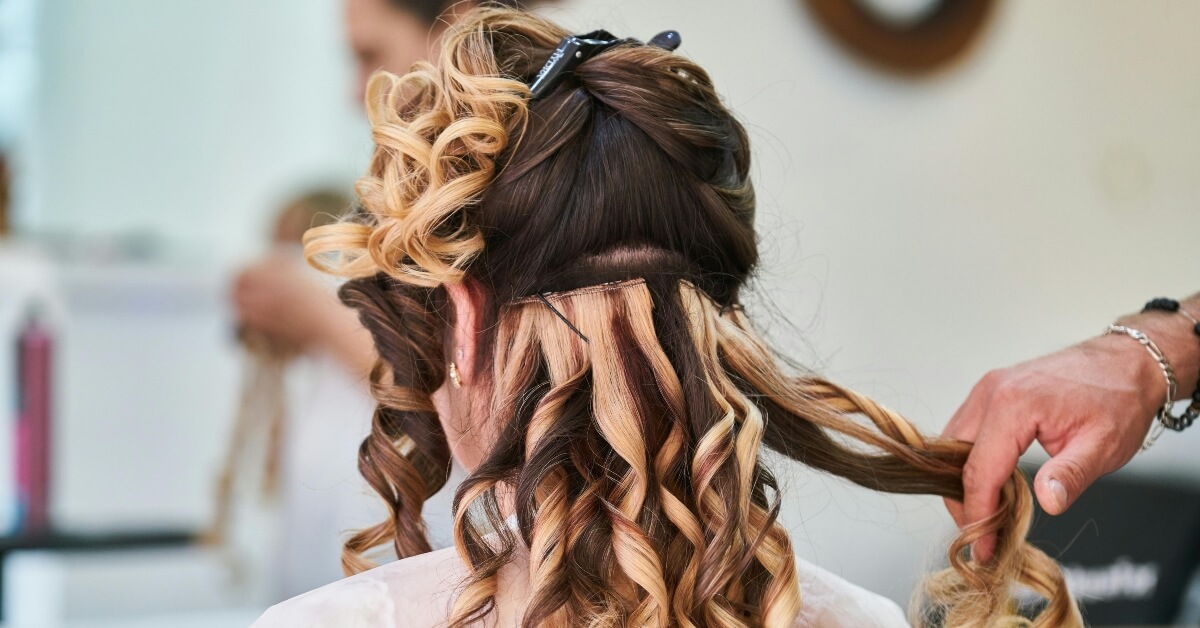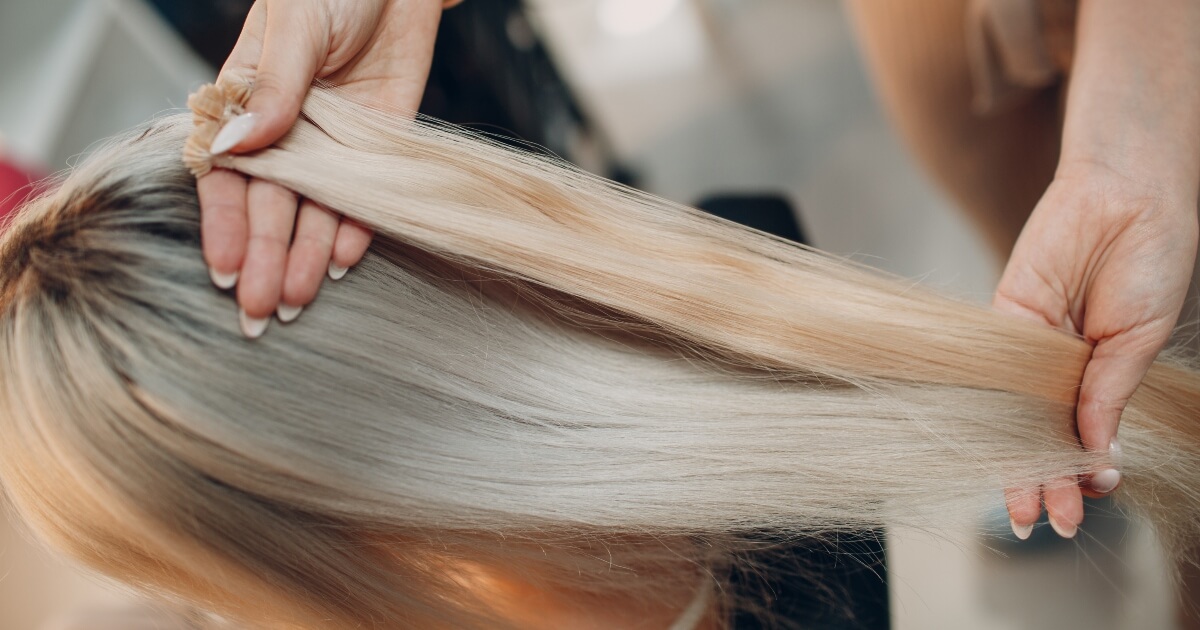Your hair feels like straw. It looks dull and lifeless. You run your fingers through it, and it feels rough and tangled. If this sounds familiar, you’re dealing with a hair moisture crisis.
Want to know why your hair feels so dry all the sudden? Find out about some of the many factors involved in hair dryness and what you can change to give your hair much-needed moisture.
If you’ve been dealing with dry hair and need help from professionals, contact Societe Salon. Our stylists not only deliver exceptional cuts, coloring and extensions. We also help our clients take proper care of their hair, so they can have the Beauty with Confidence they deserve.
Book your appointment today. Let’s get you that amazing hair you’ve been looking for!
What is This Dry Hair All About?
Let’s start with the basics about dry hair. For example, are you sure your hair is dry? What does it look like and what are the common signs?
What Does Dry Hair Actually Look Like?
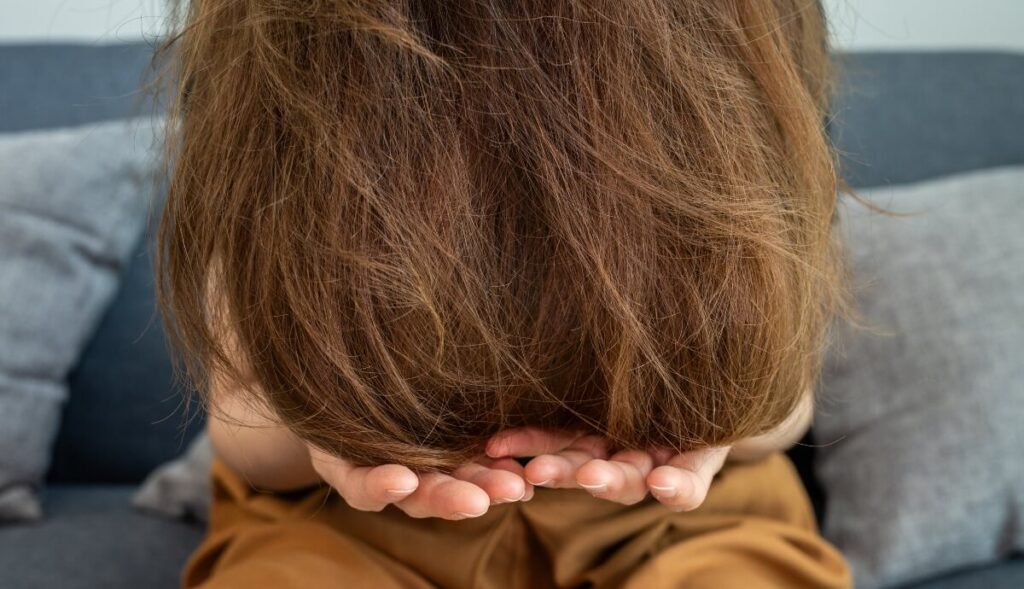
These are the obvious signs of dry hair. For example:
- Your hair feels rough when you touch it.
- It looks dull instead of shiny.
- You have a lot of split ends.
- Your hair tangles easily and breaks when you brush it.
Signs of Dry Hair You Might Miss
Your hair feels different when it’s wet. It might feel gummy or mushy.
Dry hair also takes forever to dry after washing. Plus, your hair color looks faded even if you just had it done.
Another sign if dry hair you might miss is that you are constantly seeing your hair stand up because of static electricity.
How dry hair behaves differently: Dry hair absorbs products quickly but nothing seems to help for long. Humidity makes it frizzy instantly. Heat styling seems to work at first but makes the problem worse over time.
The texture is probably the biggest giveaway. Healthy hair should feel smooth when you run your fingers down the shaft. Dry hair feels bumpy and rough.
The Science Behind Hair Moisture
Your hair’s moisture system is more complicated than you might think.
How your scalp makes oil: Your scalp has tiny glands called sebaceous glands. These make sebum, which is your hair’s natural oil. This oil is supposed to travel down your hair shaft and keep it moisturized.
Why hair cuticles matter: The outside of your hair is covered in overlapping scales called cuticles. When these lay flat, your hair looks shiny and feels smooth. When they’re raised or damaged, moisture escapes and your hair feels dry.
Think of hair cuticles like roof shingles. When they’re in good shape, they protect what’s underneath. When they’re damaged, everything gets wet and damaged.
Hair porosity affects everything: Some hair is naturally more porous than others. High porosity hair absorbs moisture quickly but loses it just as fast. Low porosity hair resists moisture but holds onto it longer once it gets in.
You can test your hair’s porosity at home. Take a strand of clean hair and drop it in a glass of water. If it sinks quickly, you have high porosity hair. If it floats for a while, you have low porosity hair.
Dry Hair vs. Normal Hair: What’s the Difference?
Healthy hair has some specific characteristics that dry hair lacks.
What Healthy Hair Looks Like
Healthy hair reflects light and looks shiny. The ends aren’t split or frayed. When you touch it, it feels smooth and soft. It doesn’t tangle easily when you brush it.
What Healthy Hair Feels Like
It has some stretch to it when wet but snaps back. It doesn’t break easily when you style it. Products seem to work well and last throughout the day.
When Dryness Becomes a Real Problem
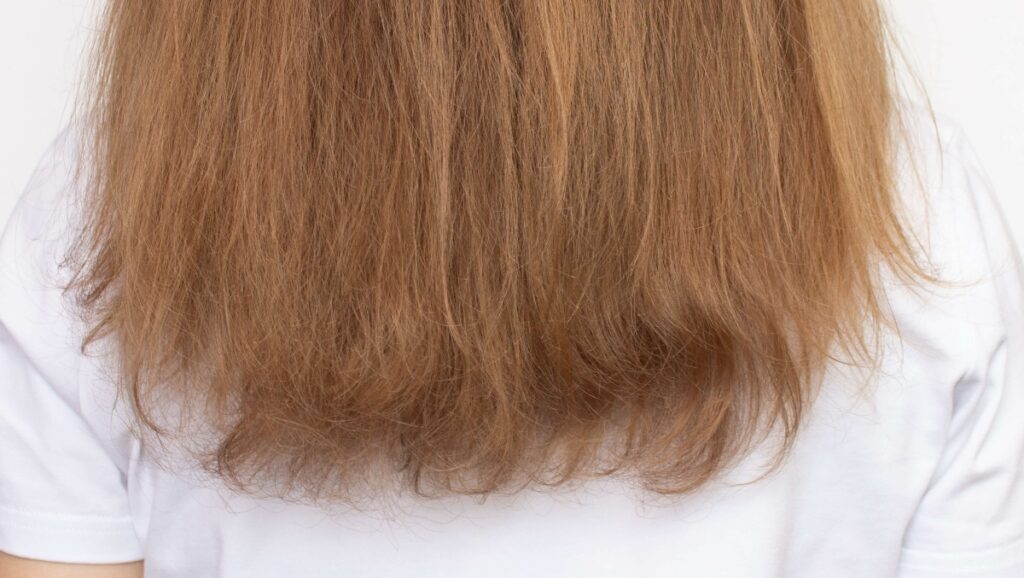
A little dryness at the ends is normal, especially if you have long hair. But if your whole head feels dry, or if the dryness appeared suddenly, that’s a problem.
Simple Tests You Can do at Home for Dry Hair
Try the stretch test. Take a wet strand of hair and gently stretch it. Healthy hair should stretch about 30 percent longer before breaking. Dry, damaged hair will snap immediately.
The shine test is simple too. Look at your hair in natural light. Healthy hair should have some shine and light reflection. Dry hair looks dull and flat.
Why Your Hair Suddenly Turned Dry: The True Culprits
If your hair was silky last month and now feels like a bird’s nest, something in particular made it happen. Hair does not become dry out of nowhere overnight without an underlying cause.
Seasonal and Environmental Conditions
Weather and your surroundings contribute greatly to hair moisture.
Winter heating systems: Dry air from indoor heating dries out your hair and everything else. Forced-air heating is especially bad because it just keeps circulating dry air constantly. Your hair deprives the surrounding air of moisture.
If you reside in a region with hard winters, you probably find that your hair starts to get drier the moment the heat is turned on.
Summer damage you can’t see: Sunlight lightens your hair and dehydrates it with time. Even when you are not trying to lighten your hair, UV light kills the proteins that help maintain hair.
Swimming pool chlorine removes natural oils from hair. So does saltwater. Even a sporadic swim will dry your hair over time.
Air conditioning: Air conditioning strips the air of moisture. That is, your hair is losing moisture to the dry air constantly surrounding you. Those who work in very air-conditioned workplaces usually experience drier hair.
Hard water: Hard water has minerals that accumulate on your hair as time goes by. This prevents water from entering into your hair shaft. It also reduces the effectiveness of shampoo.
If you’ve recently relocated or your city changed water treatment, hard water may be the reason for your newly parched locks.
Your Climate: A shift in climate from humid to dry is sufficient to jolt your hair. Your hair was adapted to retaining some moisture in the air. Take that away and your hair starts drying out at a frightening rate.
Lifestyle Changes That Sabotage Hair Moisture
Minor changes in your daily routine can have major effects on your hair, such as:
- New workout routines: Frequent workouts mean washing your hair more regularly. Every time you wash your hair, you strip some natural oils. If you had been washing your hair twice a week to washing every day, that is probably one of the reasons for abrupt dryness. Sweat also has salt in it, which dries out your hair if you let it happen over time. If you’re exercising really hard and sweating like crazy, your hair is being exposed to salt on a regular basis.
- Stress: Stress makes your scalp produce less oil. This can make your hair drier than normal if you have high stress. Stress also affects how you take care of your hair. You might reduce deep conditioning treatments or use more heat styling when stressed and not in the mood.
- Sleep and friction damage: New pillowcases, especially cotton ones, can start friction damage that makes hair feel drier. If you just changed bedding, that might be to blame. Sleeping with your hair down instead of in a protective style causes friction damage too. You toss and turn your hair all night on the pillow.
- Travel: Travel exposes your hair to other water, other air, and interrupted routines. Hotel shampoos are often harsh. Plane air is bone-dry air. Even short trips can upset the moisture balance of your hair, especially if you travel frequently.
Hair Mistakes That You Could Be Making
Sometimes the problem is what you’re subjecting your hair to, and not so much what’s happening in your surroundings.
Over-washing is probably the most common reason for sudden hair dryness. Every single wash takes away natural oils. If you started washing more often for any reason, that could be the culprit behind dryness.
Most people don’t have to wash their hair every day. Even oily scalps can usually get by every other day.
Another hair mistake is using water that’s too hot. Hot water strips your hair of oil faster than warm water. If you started using hotter showers, that could be drying out your hair. Think about how warm water you would use to wash your face.
Rubbing your hair roughly with a towel creates friction damage. This kind of damage dries out and makes hair coarser. Instead of rub, squeeze gently with the towel. Alternatively, you can use a microfiber towel or t-shirt, both of which are less damaging to hair.
If you use a lot of styling products, they build up in your hair over time. This clogs the hair and does not allow water to penetrate your hair. Even conditioner can build up when you use too much or don’t rinse it out properly.
Wet hair is also much more fragile than dry hair. Brushing it vigorously injures the hair and dries out your hair even further in the long term. If you must brush wet hair, use a wide-tooth comb and comb starting at the ends and working up.
Chemical and Heat Damage
Chemical and heat damage can add up over time, but sometimes you reach a point where your hair is just going to break and suddenly feels very dry.
Heat Styling Tool Damage
Every time you use heat on your hair, you cause some damage. This gets to accumulate over time until suddenly your hair is much dryer.
If you started using more heat tools regularly, or if you started using higher heat, that would explain sudden dryness.
Chemical Treatment
Chemicals in hair perming, relaxing, and coloring can dry out your hair. Although you might have had these procedures done previously without problems, hair becomes more prone to damage with the passage of time.
If you have recently had any chemical treatments, or have been getting them regularly for some time now, they may finally have caught up with your hair.
Swimming Pool Chemicals
Constant chlorine exposure gradually breaks down the protective coating on your hair. If you started attending the pool more frequently, or the chemicals for your pool were changed, that could be drying your hair out.
Harsh Ingredients in Hair Products
Some shampoos contain sulfates that strip oil from hair. If you started using a new shampoo containing harsher ingredients, that could contribute to immediate dryness. Styling products with alcohol can also dry hair over time.
Health and Hormonal Changes
Sometimes, though, the problem isn’t what you’re doing to your tresses – it’s what your body is doing.
Hormonal shifts: Menopause, pregnancy, and thyroid disorders all have an impact on how much oil your scalp produces. Less oil = drier hair.
Even hormone birth control changes can affect the amount of oil your hair produces. If you’ve recently begun or ended hormonal birth control, that may be the reason your hair’s been so strange lately.
Medications that dry hair out: Some medications reduce oil production or alter hair texture. Allergy medication, blood pressure medicine, and antidepressants can all leave the hair dry.
New meds: If you just started new medicines, look to see if dry hair is a side effect.
Nutrient deficiencies: Lack of protein, iron, or certain vitamins can dry and brittle the hair. If your diet recently changed, that could be drying out your hair.
Unusual crash dieting or quick weight loss can cause immediate hair change.
Age-related changes: As people grow older, their scalp naturally makes less oil. This happens slowly but sometimes abruptly.
Furthermore, age-related changes in hormones affect hair water content and texture.
Medical conditions: Autoimmune diseases, diabetes, and other health problems could influence hair health. If your dry hair occurred suddenly with other symptoms, visiting your physician might be advisable.
Age-Associated Hair Alterations: What Happens After 40?
Getting older affects your hair in manners you might not predict. Knowing the way these adjustments function helps you to change your hair care routine along with the years.
As you get older, your hair moisture system starts to work differently.
Your scalp produces less oil:
- Naturally, oil generation decreases with age
- This is a gradual process from your 30s and 40s
- At menopause, most women secrete considerably less scalp oil
- Oil glands reduce in size and become less active
Oil doesn’t travel as smoothly: Your hair shaft changes texture with age. It becomes coarser and more porous. This causes it to be harder for the oil from your scalp to travel down to your ends.
It’s like trying to slide down a wax slide versus a sandpaper slide. The oil that used to slide over your hair now gets blocked halfway down.
Hair porosity increases:
- Hair cuticles become increasingly damaged
- Years of styling, sun, and shampooing accumulate
- Cuticles that are damaged cannot hold water as well
- Hair dries faster and is more porous
Gray hair acts differently: Gray hair is made up entirely differently than colored hair. It’s typically coarser and less moisturizable. Most women find that their hair dries out as they gray, even before menopause strikes.
Hormonal Shifts and Hair Dryness
Hormones control oil secretion in your scalp. When hormone levels change, so does your hair.
Menopause and estrogen: Estrogen helps regulate oil production. Your scalp makes less oil when estrogen levels drop with menopause. That’s why so many women find their hair drier in their 40s and 50s.
Thyroid problems become more common:
- Thyroid disease is more common with age
- Overactive and underactive thyroid both affect hair
- Hypothyroidism can cause brittle, dry hair
- Changes in hair can be an early sign of thyroid disease
Insulin resistance: Many women become insulin resistant with age. It can affect blood flow to your scalp and reduce oil production.
Medication Side Effects
Older adults take more medications, some of which dry out hair:
- Blood pressure drugs
- Cholesterol-lowering medications
- Antidepressants
- Allergy medications
- Heart drugs
Collaborating with your physician: Don’t abruptly stop medicines prescribed by your doctor. In some cases, it is helpful to change to a different medicine within the same group. Sometimes you just need to change how you take care of your hair.
Supplements that can help: Some supplements are good for hair health, but always talk to your doctor before taking a new supplement. Omega-3 oils, biotin, and collagen supplements are the most in-demand. Professional vs. DIY Diagnosis: Know When to Call in the Experts
Sometimes, sudden hair dryness is indicative of an issue. Knowing when to call in the experts can save you time and prevent further damage.
When Sudden Hair Dryness Indicates an Issue
Red flags that require attention:
1. Hair loss and dryness – If you’re losing much more hair than normal
2. Scalp alteration – Itching, flaking, redness, or soreness
3. Drastic texture alteration – Hair that’s very different one morning
4. Other symptoms – Fatigue, weight gain or loss, mood swings
5. Excessive breakage – Hair breaking off rather than simply being dry
Medical Conditions Associated with Hair Dryness:
- Thyroid disorders (extremely common)
- Autoimmune disorders
- Hormonal imbalances
- Nutritional deficiencies
- Diabetes
- Eating disorders
When timing is everything: If your hair dryness occurred with the onset of new medications, significant life stress, important weight loss, or other changes in health, it’s worth looking into further.
Identifying Different Types of Hair Loss Leading to Sudden Dryness
Sometimes what you feel as sudden dryness of hair is really the beginning of hair loss. As hair follicles weaken or shut down, the available hair begins to dry out and become brittle before eventually falling out. Understanding the different types of hair loss makes you aware of whether your dry hair is part of a larger trend.
Autoimmune Hair Loss (Alopecia Areata)
It happens when your immune system accidentally attempts to destroy your hair follicles. The initial symptom is often sudden areas of hair loss, but many comment that their hair becomes unusually dry and brittle during the weeks leading up to actual hair loss.
Alopecia areata can occur in anyone at any age but most commonly starts in childhood or early adulthood. The hair loss typically will occur in smooth, round areas, but the hair bordering the area can be noticeably different in texture before the disease is visible.
Pattern Hair Loss (Androgenetic Alopecia)
This is the most common type of hair loss in both men and women. In females, it usually starts with thinning everywhere and not with certain balding areas. The hair becomes increasingly finer, drier, and more brittle with time.
Women with pattern baldness know their hair is different before they notice any detectable thinning. Hair becomes harder to style, more coarse, or more likely to break. This type of loss of hair is genetic and hormonal in nature, which is why it happens around the same time that other hormonal changes occur.
Stress-Related Hair Loss (Telogen Effluvium)
When your body experiences tremendous stress – either emotional or physical – it can push tremendous numbers of hair follicles into the resting phase. This causes massive hair loss 2-3 months later following the cause.
Common causes include severe illness, surgery, extreme weight loss, extreme emotional stress, or childbirth. The hair that will be lost will begin to dry out and appear dead weeks before it actually sheds. This is your hair follicle’s cue to close down for a short time.
Damage-Related Hair Loss (Traumatic Alopecia)
This type of hair loss is due to physical damage to the follicle or shaft. It may be caused by overuse of heat styling, chemicals, tight hair styles, or abusive handling. The hair becomes weaker and dryer until it is snapped off at the scalp.
Unlike other types of hair loss, traumatic alopecia can be completely prevented. The trick is to catch early warning signs – dryness, brittleness, and breakage – before damage is irreversible.
Why Professional Diagnosis is Important
All types of hair loss require different treatment. What stops shedding caused by stress won’t cure autoimmune hair loss. Using the wrong products will actually make some conditions worse.
A dermatologist might be able to check you just to find out what type of hair loss you are experiencing. He or she will do a pull test, examine your scalp under the microscope, or take a small biopsy. Blood work can rule out hormonal imbalances or nutrient deficiencies.
The sooner you get a proper diagnosis, the greater your chances of having available treatment options. Some hair loss patterns can be completely restored if treated early, and some can be slowed down or stopped with proper medical attention.
Having trouble with your hair? Let our elite stylists get to work on creating beautiful hair. Schedule your appointment right away!
Working with Hair Professionals
A professional stylist will be able to evaluate the condition of your hair. They will know if there’s heat damage, chemical processing or environmental stress.
When you sit down in your stylist’s chair, there are several questions you should ask about the condition of your hair:
- Is it damage, or is it just dryness?
- What’s the probable cause based on the condition of my hair?
- How long will it take before things get better?
- What professional treatments would be most beneficial?
- Are my home products creating more problems?
You should see a dermatologist if your scalp is involved (itching, flaking, redness) or if you have significant hair loss, see a dermatologist. They can make diagnoses like seborrheic dermatitis or alopecia.
Testing Your Dry Hair at Home
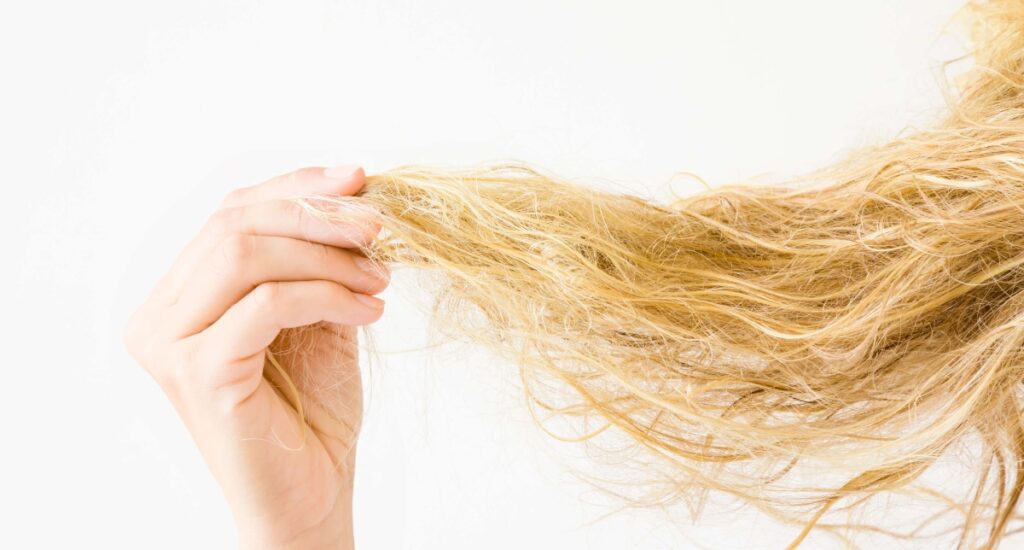
The Porosity Test
1. Take a clean hair strand
2. Plunge it into a glass of water
3. Highly porous hair sinks rapidly
4. Low-porosity hair will float
5. Normally porosity hair will sink slowly
The Stretch Test
- Hold a wet lock of hair
- Gently stretch between your fingers
- Normal, healthy hair stretches to around 30% before it snaps
- Dry, broken-up hair snaps right away
- Over-processed hair stretches excessively and is gummy
Visual Test
- Make sure to inspect for split ends (damage sign)
- Look at your hair’s shine in natural light
- Test the texture – smooth or rough
- Check how the products absorb – too quickly may be too high porosity
Keep notes about when you catch changes happening. This helps to identify patterns and potential causes. Document such as new products, medication changes, stress levels, and seasonal changes.
The Whole Hair Moisture Recovery Program
There is a solution by step to fixing dry hair. You need on-the-spot damage repair as well as long-term modifications so that the problem comes back.
On-The-Spot Damage Repair (First 2 Weeks)
Stop immediately the following:
- Heat styling without protecting gear
- Washing hair in hot water
- Rough towel drying
- Brushing wet hair vigorously
- Using sulfates or alcohol-based products
Emergency Hydrating Treatments
Week 1: Deep condition twice with a protein-free moisturizing mask. Use it on mid-lengths and ends, not roots.
Week 2: Add a leave-in treatment after every shampoo. Something light that won’t weigh your hair down.
Quick texture fixes: Apply a small amount of hair oil to wet hair before styling. Argan, jojoba, or coconut oil will work for most hair. Start with a few drops.
Protect what you have: Sleep on a silk or satin pillowcase. This reduces friction that dries out your hair. If you don’t have silk pillowcases, tie your hair up in a silk scarf.
Building Your New Shampooing Routine
Most can reduce washing frequency:
- Fine hair: every other day, at most
- Medium hair: 2-3 times a week
- Thick or curly hair: 1-2 times a week
- Extremely dry hair: once weekly to begin
Shampoo with lukewarm water and rinse with cool water. Natural oils are stripped away by hot water quicker than anything else you could possibly do to your hair.
How to Correctly Dry Your Hair
- Gently squeeze water out of hair with hands
- Press hair between towel layers (do not rub)
- Let hair air dry 50-70% before any heat is used
- Use lowest heat setting possible on blow dryer
- Always apply heat protectant before any heat styling
Weekly Hair-Washing Schedule
- 1-2 wash days with gentle shampoo and conditioner
- 1 deep conditioning treatment
- 1 protein treatment if needed (only if hair is mushy)
- Daily usage of leave-in treatment
- Nighttime protection (silk pillowcase or hair wrap)
Choosing Hair Products with the Right Ingredients
Look for these hydrating ingredients like:
- Hyaluronic acid
- Glycerin (except in rainy weather)
- Ceramides
- Natural oils (argan, jojoba, coconut)
- Shea butter
- Panthenol (Pro-Vitamin B5)
Avoid these drying ingredients:
- Sulfates (sodium lauryl sulfate, sodium laureth sulfate)
- Denatured alcohol (alcohol denat)
- Isopropyl alcohol
- Excessive protein (can exacerbate dryness)
Shampoo daily with sulfate-free shampoos. If you have heavy product buildup, use a clarifying shampoo every 2-3 weeks with an immediate deep conditioning treatment.
Your conditioner should be one level higher in strength than the shampoo. If your shampoo is mild, you might use a rich, heavy conditioner. Balance the level with the level of dryness of your hair.
Leave-in Treatment Regimen
- Fine hair: light water-based leave-ins
- Medium hair: cream leave-ins
- Thick/coarse hair: oil or heavy cream leave-ins
- Extremely damaged hair: repair ingredient products
Deep Treatment Regimen
- Week 1-4: Deep condition every other week
- Week 5-8: Deep condition weekly
- Week 9+: Deep condition every 2 weeks as necessary
Protein vs. Moisture Treatments
Use protein treatments when:
- Wet hair is mushy
- Excessive stretching occurs and it refuses to snap back into position
- Hair is highly damaged due to chemical processing
Use moisture treatments when:
- You have dry, rough hair
- Hair tends to break
- Hair appears dull and brittle
How to Apply Moisture Treatment
- Use on wet (not soaking) hair
- Focus on mid-lengths and ends
- Distribute using a wide-tooth comb
- Top with a shower cap for deeper penetration
- Leave on for 15-30 minutes (follow product directions)
- Cool water rinse thoroughly
Oil treatment regimen: Do oil treatments on dry hair before shampooing. Apply oil to dry hair, leave 30 minutes to 2 hours, and shampoo afterwards. This prevents oil from weighing your hair down.
Environmental Protection Strategies
Use heat protectant on wet hair prior to heat styling. Ensure that each strand is well covered. Reapply if your hair becomes dry while styling.
You also need to protect your hair from UV light:
- Utilize hair care products with SPF when outdoors
- Use hats or scarves to shade from sun physically
- Restrict sun exposure between 10am and 4pm
- Wash hair using clean water after swimming in chlorinated pools
Protect your hair from humidity by:
- Using anti-humidity styling products on humid days
- Avoiding glycerin-based products when there is high humidity
- Investigating protective styles that keep hair contained when it’s humid
At night, your goal should be to reduce friction and moisture loss. Choose one of the following options based on your hair length and sleeping position:
- Silk or satin pillowcases
- Silk hair wraps or bonnets
- Loose braids or buns with silk scrunchies on top
- “Pineapple” technique for curly hair (very loose high ponytail)
Natural and Homemade Remedies That Actually Work
Your kitchen is stocked with some surprisingly good remedies for dry hair. But not all homemade treatments are created equal, and it’s worth knowing which ones actually penetrate the hair shaft instead of merely coating the surface.
Making an Effective Homemade Mask Using Common Household Items
Honey is perhaps one of the least appreciated hair treatments in your pantry. This natural humectant draws moisture from the air and traps it in your hair shaft. Mix two tablespoons of raw honey and one tablespoon of olive oil for an intense moisturizing mask that can be left on for 20-30 minutes.
Avocado masks work well because they are so full of natural oils and vitamins E and B. The luxurious texture makes it spread well throughout your hair, and the good fats seep into the hair cuticle rather than sitting on the surface. Mash an overripe avocado and blend with a tablespoon of coconut oil for best effect.
Egg treatments have been around for centuries, and there is solid science behind why they are effective. Egg yolks are rich in lecithin, an emulsifier that repairs damaged hair cuticles. Egg proteins can temporarily fill gaps of damaged hair, causing it to feel thinner and look brighter.
Which Natural Oils Penetrate Hair and Which Ones Just Coat It?
Not all oils are created the same when dealing with hair. Coconut oil, argan oil, and jojoba oil have smaller molecules that can penetrate into the shaft of the hair and provide long-lasting moisture. These oils are able to repair from within.
Heavier oils like olive oil and castor oil just coat the hair shaft. While this will produce fleeting smoothness and sheen, they are not the same long-term moisturizing actives. That said, glossing oils may be great for protecting hair from weather stress and heat styling.
Safety Considerations for Homemade Treatments with Natural Oils
Always do a patch test on any homemade treatment in a small section of hair first. Some people are allergic to common ingredients like eggs or oils. Also, be careful with acidic ingredients like lemon juice or apple cider vinegar because they can ultimately dry out your hair when used frequently or in excess.
Never leave treatments with protein content (e.g., egg masks) on longer than directed. Too much protein may make hair brittle and prone to breakage. If your hair becomes rigid after a protein treatment, use a moisturizing conditioner afterward.
Changing Your Lifestyle to Better Hydrate Your Hair
Drinking lots of water is simple, but it won’t be a magic formula for dry hair. Your hair is nourished by your blood, so what you eat matters more than the amount of water you drink. Consume foods rich in omega-3 fatty acids like salmon, walnuts, and flaxseeds. These healthy fats are healthy for your scalp’s natural oil production.
Biotin from eggs and nuts helps to maintain hair structure. Dryness of the hair could be a sign of iron deficiency, so consume iron-rich foods like spinach and lean meat. But if you suspect there is a nutritional deficit, it’s better to get the blood tests done than to try out supplements.
Sleep Habits That Preserve Hair Moisture
Your pillowcase is more significant than you think. Cotton pillowcases can create friction that pushes your hair cuticle out and dries your hair out. Switch to silk or satin pillowcases, or sleep with a silk scarf or bonnet on your hair.
Loose braids or loose buns can prevent tangles without tension that leads to breakage. Avoid tight elastics or any product with metal components that catch in your hair.
Exercise Differently to Keep Your Hair Moist
Shampooing your hair after exercise on a regular basis dries it out. If you exercise every day, rinse some days with just water instead, or replace shampooing each time with co-wash (conditioner-only washing).
Exercise-related tight ponytails may lead to breakage at the hairline. Vary the position of your ponytail and use fabric-covered elastics to prevent forming weak areas in your hair.
Manage Your Stress
Chronic stress affects your entire body, and that includes your hair. Prolonged cortisol levels can disrupt your hair growth cycle and affect the health of your scalp. Stress management won’t fix dry hair overnight, but it keeps your overall hair healthy in the long term.
Simple stress-reduction strategies like deep breathing, regular exercise, or meditation can work for you. If you’re severely stressed, don’t hesitate to consult professional advice.
Affordable Professional Alternatives
Drugstore Products Equivalent to Salon Therapy
Breaking the bank isn’t necessary for fantastic hair care. Purchase ceramide-infused drugstore deep conditioning treatments that restore the hair’s protective barrier. L’Oréal and Garnier offer top-of-the-line products at a fraction of the cost.
Leave-on products with argan oil or keratin can provide all-day moisturization. These may be as effective as the expensive counterparts because they contain the same active ingredients.
How to Create Spa-Quality Treatments at Home
Steaming treatments can really help improve how well products penetrate your hair. After a deep conditioning mask, wrap your hair in a warm, damp towel for 15-20 minutes. The heat will cause your hair cuticles to open so the treatment will be able to penetrate more effectively.
You can also prepare your own hot oil treatment by heating coconut or argan oil (use your wrist to test the temperature before applying) and then applying it to damp hair. Cover with a shower cap and let the heat do its magic.
Multi-Purpose Products That Save Money and Space
Coconut oil serves as a pre-shampoo treatment, deep conditioner, and styling cream all-in-one. A little goes a long way, making it super affordable.
Apple cider vinegar is a clarifying treatment to remove buildup and pH-balancing rinse to smooth the hair cuticle. Mix one part vinegar with three parts water as a weekly clarifying treatment.
Solutions for Extreme Dryness
Keratin Treatments for Hydration and Manageability
How keratin treatments work is that they fill in broken hair cuticle gaps with protein. This creates a smoother, more reflective surface and better ability to retain moisture. The last 3-4 months and can reduce frizz significantly as well as enhance manageability.
But then these treatments do contain formaldehyde or formaldehyde-releasing agents, so they’re not for everyone. Pregnant women need to avoid them, and ventilation must be done when applying.
Olaplex and Bond-Building Treatments
Olaplex rebuilds the broken disulfide bonds at the molecular level in your hair. Disulfide bonds are what give strength and structure to hair. When compromised by heat, chemicals, or the environment, hair is stripped of strength and dries out.
Bond-repair treatments can be particularly beneficial for hair that’s been tormented by bleaching, overheat styling, or chemical processing. The damage builds up, so your hair gets better with each treatment.
Professional Deep Conditioning Systems
Professional salon deep conditioning treatments utilize professional-strength ingredients and methods that you can’t replicate at home. Many of them include ingredients like hydrolyzed proteins, amino acids, and proprietary moisturizers that penetrate more deeply than supermarket products.
Application is also important. Professional stylists become skilled at applying products evenly and using steam or heat methods to create maximum penetration.
When to Invest in Salon Treatments vs. At-Home Care
If your hair is seriously damaged from chemical processing or excessive heat styling, professional treatments are often worth the expense. They are able to achieve startling results that would take months to achieve with at-home care alone.
For normal maintenance and slight dryness, routine care at home will usually be enough. The key is to be realistic about what you can do and how many hours you are willing to spend in hair care.
Dealing with Underlying Medical Issues
Working with Healthcare Professionals on Hormonal Issues
Hormonal shifts in menopause, pregnancy, or from thyroid conditions can deeply influence hair texture and moisture content. If your dry hair coincided with other symptoms such as fatigue, weight alterations, or irregular menstruation, it is worth exploring with your healthcare provider.
Hormone replacement therapy or treatment with thyroid medication may occasionally correct hair health, but these choices need to be made with medical advice as part of thorough health evaluations.
Supplements That Support Hair Moisture
While a balanced diet is the best method of obtaining nutrients, some people benefit from supplements. Supplements of omega-3 fatty acids can support the health of the scalp and regular oil production. Biotin supplements could be useful if you are low, but biotin is easily accessed through most diets.
Always consult a healthcare professional prior to supplement intake, especially if you are taking other medications. Some supplements interact with drugs or cause side effects at high doses.
Treating Scalp Conditions That Contribute to Dryness
Scalp conditions like seborrheic dermatitis or psoriasis can affect the amount of moisture in your hair. These tend to require medicated shampoo or topical medicine from a dermatologist.
Even mild scalp irritation is enough to throw off your hair’s natural defense barrier. If you notice flaking, itching, or redness along with dryness in your hair, it is time to have a professional examine your scalp.
Managing Medication Side Effects
Numerous widely used medications have an impact on hair moisture as a side effect. Medications for high blood pressure, antidepressants, and cholesterol-lowering pills are among the most prevalent offenders.
Do not discontinue prescribed medications without talking to your healthcare provider first. Instead, discuss your concerns and inquire about alternatives or adjusting medications to reduce side effects.
How to Avoid Future Moisture Emergencies
Regularity is the secret to preventing sudden hair dryness. Develop a routine that includes regular deep conditioning, heat protection, and gentle care practices. Healthy hair is simpler to maintain than damaged hair is to repair.
Pay attention to changes in your surroundings, lifestyle, or health that may impact your hair. Adjusting your routine beforehand can prevent problems from worsening.
Seasonal Routine Changes
Your hair has shifting requirements with the seasons. Winter weather is dry and can steal moisture from your hair, and summer sun and chlorinated pools create other types of damage. Changing products and routines with the seasons will help to keep your hair in the same health at all times.
Winter might need richer, more moisturizing products. Summer might need lighter sunscreen products.
Age-Appropriate Hair Care Modifications
As you age, your hair will also become more dry and brittle naturally. Hormonal changes, decreased oiliness, and build-up styling damage are all contributing factors. Shifting your routine to be less harsh and more moisturizing can help maintain healthy hair as you age.
This may involve less frequent washing, more frequent conditioning treatments, and being even more careful with heat styling and chemical processing.
Building Sustainable Habits for Lifelong Hair Health
Your hair care routine should be one that you can use every day. Choose products and techniques that fit your budget and lifestyle. It’s better to do small things daily than attempt elaborate routines and only abandon them after several weeks.
Prioritize protecting your hair from damage rather than trying to fix issues when they arise. This approach is more efficient and cost effective in the long run.
Frequently Asked Questions About Sudden Dry Hair
Why Does My Hair Dry Out Even Though I Condition it Every Day?
Daily use of conditioner is a good idea, but the conditioner itself is important. If you have very dry hair and are using a lightweight conditioner, it could be too light for your hair. Also, if you’re not rinsing your shampoo well or if you’re using water that is too hot, these things can negate the good that your conditioner is doing. Try using a more moisturizing, richer conditioner or incorporating a weekly deep conditioning treatment.
How Long Does it Take to Rejuvenate Extremely Dry Hair?
Extremely dry hair typically takes 6-8 weeks to notice drastic change with regular maintenance. You should, nonetheless, notice some change in 1-2 weeks of adopting proper moisturizing routine. Depending on severity of damage and your compliance with your new regimen, the time differs. Remember, hair grows half an inch monthly, so complete renewal takes time.
Can Consuming More Water Improve Dry Hair?
Although it is crucial to stay hydrated for general health, drinking more water will not specifically cure dry hair. Hair acquires moisture from outside use, not from your bloodstream. Severe dehydration, though, can impact the health of your scalp and oil glands, so being well-hydrated keeps your entire hair system healthy as part of a healthy combination of things.
Is it Typical For Hair to Become Drier as One Ages?
Yes, hair will get drier with age due to decreased oil from your scalp, hormonal shift, and friction from years of styling and exposure to the weather. It’s completely natural, though, and it’s an indication that you’ll need to change your hair care regimen to provide extra moisture and protection as you get older.
Should I Just Trim Off All My Dry Hair or Try to Repair It?
Unless your hair is in emergency damage with extensive breakage, it’s usually best to try to repair it in the first place. Start by giving it rich moisturizing treatments for 4-6 weeks. If it doesn’t get better, or if your hair has severe split ends, a cut can help get rid of the worst of it while you obtain the rest repaired. A professional stylist can provide the best advice on how to proceed.
What are the Distinctions Between Dry Hair and Damaged Hair?
Dry hair is dry but has a structure, while damaged hair is not only dry but also has structural problems such as cracked cuticles or protein loss. Dry hair is usually rough to the touch but not brittle, while damaged hair is brittle and breakage-prone. Dry hair can be treated with moisturizing treatments, while damaged hair is treated with protein treatments or professional repair services.
Can Stress Really Dry Out Your Hair Overnight?
Even though stress won’t literally dry your hair overnight, it may lead you to alter your hair care routine (e.g., washing more frequently or messing with your hair more) or affect your scalp to secrete less or more oil. Prolonged stress also leads to states of hair loss that make your existing hair appear to be drier. The “overnight” change you notice might be due to the accumulated stress over time.
Are Expensive Hair Products Worth it for Dry Hair?
Not always. High-end shampoos and conditioners contain the same active ingredients as cheap drugstore versions. Some of the expensive products simply contain more of the active ingredients or more complicated formulations. It is a matter of reading labels and finding products that work for your own hair type, which can be either cheap or expensive. At times the $5 drugstore conditioner works better than the $50 salon version, depending on the needs of the hair.
